
Mintaka, designation Delta Orionis and 34 Orionis, is a multiple star system some 1,200 light-years from the Sun in the constellation of Orion. Together with Alnitak and Alnilam, the three stars form Orion's Belt, known by many names among ancient cultures. The star is located very close to the celestial equator. When Orion is near the meridian, Mintaka is the rightmost of the Belt's stars when viewed from the Northern Hemisphere facing south.

Iota Orionis is a multiple star system in the equatorial constellation of Orion the hunter. It is the eighth-brightest member of Orion with an apparent visual magnitude of 2.77 and also the brightest member of the asterism known as Orion's Sword. It is a member of the NGC 1980 open cluster. From parallax measurements, it is located at a distance of roughly 1,340 light-years from the Sun.

Delta Scuti, Latinized from δ Scuti, is a variable star in the southern constellation Scutum. With an apparent visual magnitude that fluctuates around 4.72, it is the fifth-brightest star in this small and otherwise undistinguished constellation. Analysis of the parallax measurements place this star at a distance of about 199 light-years from Earth. It is drifting closer with a radial velocity of −45 km/s.

74 Aquarii is a triple star system in the constellation of Aquarius. 74 Aquarii is its Flamsteed designation and it also bears the variable star designation HI Aquarii. The combined apparent visual magnitude is 5.8, although it is very slightly variable, and it is located at a distance of 590 light-years from Earth.

Sigma Orionis or Sigma Ori is a multiple star system in the constellation Orion, consisting of the brightest members of a young open cluster. It is found at the eastern end of the belt, south west of Alnitak and west of the Horsehead Nebula which it partially illuminates. The combined brightness of the component stars is magnitude 3.80.

Pi Cassiopeiae, Latinized from π Cassiopeiae, is a close binary star system in the constellation Cassiopeia. It is visible to the naked eye with an apparent visual magnitude of +4.949. Based upon an annual parallax shift of 18.63 mas as seen from Earth, this system is located about 175 light years from the Sun.
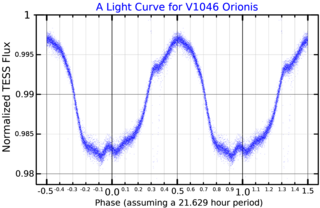
HD 37017 is a binary star system in the equatorial constellation of Orion. It has the variable star designation V1046 Orionis; HD 37017 is the identifier from the Henry Draper Catalogue. The system is a challenge to view with the naked eye, being close to the lower limit of visibility with a combined apparent visual magnitude of 6.55. It is located at a distance of approximately 1,230 light years based on parallax, and is drifting further away with a radial velocity of +32 km/s. The system is part of star cluster NGC 1981.

DV Aquarii is a binary star system in the zodiac constellation of Aquarius. It has a peak apparent visual magnitude of 5.89, which is bright enough to be visible to the naked eye. The distance can be estimated from its annual parallax shift of 11.2 mas, yielding a separation of 291 light years.

V1472 Aquilae is a triple star system in the equatorial constellation of Aquila. It is a variable star that ranges in brightness from 6.36 down to 6.60. The system is located at a distance of approximately 780 light years from the Sun based on parallax. It is a high-velocity star system with a radial velocity of −112 km/s.

S Monocerotis, also known as 15 Monocerotis, is a massive multiple and variable star system located in the constellation Monoceros. It is the brightest star in the Christmas Tree open cluster in the area catalogued as NGC 2264.

14 Lacertae is a binary star system in the northern constellation Lacerta, located around 1,600 light years away. It has the variable star designation V360 Lacertae; 14 Lacertae is the Flamsteed designation. The system is barely visible to the naked eye in good seeing conditions, having a peak apparent visual magnitude of 5.91. It is moving closer to the Earth with a heliocentric radial velocity of −16 km/s.
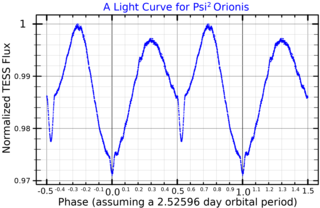
Psi2 Orionis a binary star system in the equatorial constellation of Orion. It has an apparent visual magnitude of 4.6, indicating that it is visible to the naked eye. Based upon an annual parallax shift of 2.87 mass, it is roughly 1,100 light years distant from the Sun.

HR 273 is a chemically peculiar spectroscopic binary system in the northern circumpolar constellation of Cassiopeia. It has an apparent visual magnitude of 5.9 making it faintly visible to the naked eye from dark suburban skies. Parallax measurements with the Hipparcos spacecraft put this system at a distance of roughly 350 light years.

HD 151932, also known as WR 78, is a Wolf-Rayet star located in the constellation Scorpius, close to the galactic plane. Its distance is around 1,300 parsecs away from the Earth. Despite being a blue-colored Wolf-Rayet star, it is extremely reddened by interstellar extinction, so its apparent magnitude is brighter for longer-wavelength passbands. HD 151932 lies about 22′ west of the open cluster NGC 6231, the center of the OB association Scorpius OB1; it is not clear whether it is a part of the association or not. With an apparent magnitude of about 6.5, it is one of the few Wolf-Rayet stars that can be seen with the naked eye.

GW Orionis is a T Tauri type pre-main sequence hierarchical triple star system. It is associated with the Lambda Orionis star-forming region and has an extended circumtrinary protoplanetary disk.
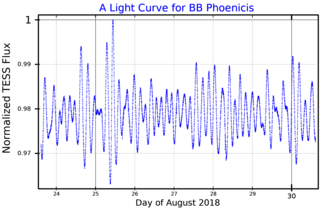
BB Phoenicis is a variable star in the constellation of Phoenix. It has an average visual apparent magnitude of 6.17, being visible to the naked eye with excellent viewing conditions. From parallax measurements by the Gaia spacecraft, it is located at a distance of 448 light-years from Earth. Its absolute magnitude is calculated at 0.6.
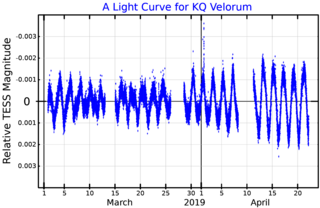
KQ Velorum is a variable star system in the southern constellation of Vela. It has the identifier HD 94660 in the Henry Draper Catalogue; KQ Vel is the variable star designation. This appears as a sixth magnitude star with an apparent visual magnitude of 6.112, and thus is dimly visible to the naked eye under suitable viewing conditions. The system is located at a distance of approximately 373 light years from the Sun based on parallax measurements, and is drifting further away with a radial velocity of around 23 km/s.
KS Persei is a binary system in the equatorial constellation of Perseus. It is sometimes known as Bidelman's Star, named after William P. Bidelman. The star is invisible to the naked eye with a mean apparent visual magnitude of 7.70. As of 2018, the structure and evolutionary history of this system remain uncertain, although some form of mass transfer is likely to have occurred to explain the observed properties.

FG Virginis is a well-studied variable star in the equatorial constellation of Virgo. It is a dim star, near the lower limit of visibility to the naked eye, with an apparent visual magnitude that ranges from 6.53 down to 6.58. The star is located at a distance of 273.5 light years from the Sun based on parallax measurements, and is drifting further away with a radial velocity of +16 km/s. Because of its position near the ecliptic, it is subject to lunar occultations.
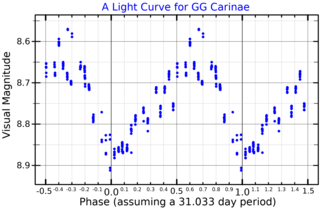
GG Carinae is a binary star system in the southern constellation of Carina, abbreviated GG Car. It is a variable star with a brightness that fluctuates around an apparent visual magnitude of 8.67, making it too faint to be visible to the naked eye. The distance to this system is approximately 8,000 light years based on parallax measurements.



















